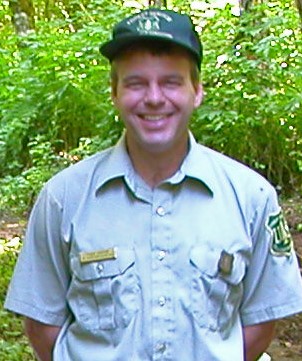The Partnership for the 21st Century Conservation Corps has selected several partners who work with 21CSC programs to recognize as “21st Century Conservation Service Corps Champions of the Week.” This week, Tom Davis, Trails Specialist for the U.S. Forest Service’s Skykomish Ranger District kindly agreed to answer our questions about working with youth programs via email. He was nominated by Jeff Parker, Executive Director of Northwest Youth Corps for this recognition. Jeff says that “from remote wilderness projects to front country work in one of our nation’s busiest forests, Tom is fully committed to engaging youth and young adults in meaningful ways to help develop the next generation of citizen stewards.”
Thanks to Tom for participating and sharing his thoughts.

Tom Davis is Trails Specialist for the U.S. Forest Service’s Skykomish Ranger District, Mt. Baker-Snoqualmie National Forest.
Click here to meet our other 21CSC Champions of the Week.
How long have you been working for the U.S. Forest Service and how did you get started?
Over 25 years. I started when I was 16-years-old with the Youth Conservation Corp on the Naches Ranger District, Wenatchee National Forest. After a number of seasons I received my permanent appointment in 1990 on the Skykomish Ranger District, Mt. Baker-Snoqualmie National Forest.
When did you start working with young people, and specifically conservation corps?
The first youth corps I worked with was Northwest Youth Corps in 1993. I also worked with some Boy Scout troops in the early 1990s.
Why do you think it’s important to connect young people to public lands and the conservation field?
Youth represent the future generation and we need to foster a good land ethic and appreciation for the outdoors for now and the future.
How do Corps better prepare Corpsmembers and crew leaders for natural resource and conservation careers, and how do you think land managers can help youth make the most of their experience?
Corps teach youth a good work ethic, how to work in the woods, and how to appreciate the woods. It is important that land managers identify and design projects with Corps crews in mind—something challenging but achievable.
From your experience, what are the most suitable projects to work on with Corpsmembers?
As beginners in trail work they are bested suited to labor intensive projects such as grubbing new trail tread or filling a turnpike.
What type of funding have you and your agency used to support partnering with a conservation corps?
Grants from the Washington State Recreation and Conservation Office (gas tax funds) supported with FS funds for coordination plus 21st Century funds. Northwest Youth Corps received matching funds from the National Forest Foundation.
The 21st Century Conservation Service Corps has the potential to bring significant attention to the work young people can accomplish on public lands and in their communities. It also has the potential to bring more funding across federal, state, and local agencies to support conservation corps and other youth programs. Given that many initiatives and programs come and go, what do you think will give the 21CSC staying power, and help it leave behind a unified legacy that captures the American imagination like the Civilian Conservation Corps?
Showcasing projects completed by Corps crews and promoting the positive aspects of Corps crews.
Is there anything else you would tell land management agency employees interested in partnering with a local Corps?
It is often easier to obtain grants if Corps crews are utilized and the Corps crews can get a lot of work done if the project is well thought out. Utilizing Corps crews is a great way to get kids in the woods and promote a good land ethic in youth. It also fun working with youth Corps and you feel like the youth are getting a lot out of their experience.
